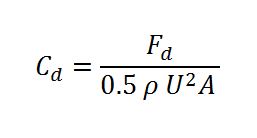...
As one can see from the data above, the plate experiences a drag of approximately 0.008377 Newtons. Furthermore, the data states that the drag coefficient is approximately 0.01675. The drag coefficient is defined by the following equation.
In the case here, the density, velocity and area all have values of 1. Thus, the equation above reduces to the following equation.
The results from ANSYS FLUENT agree with the theory here since the drag coefficient is approximately twice the value of the drag.
Now, save your work in the FLUENT window, then close the FLUENT window.
Go to Step 7: Verification & Validation
See and rate the complete Learning Module
Go to all FLUENT Learning Modules
 Sign-up for free online course on ANSYS simulations!
Sign-up for free online course on ANSYS simulations!
